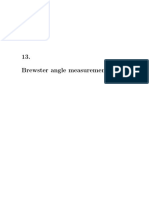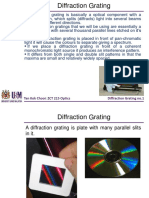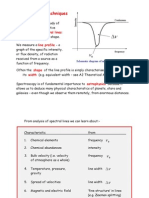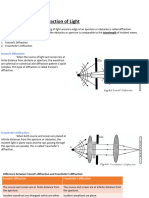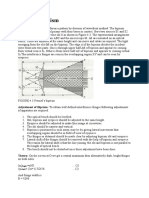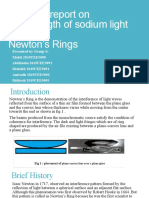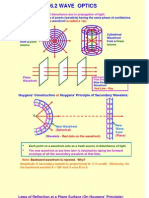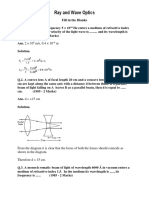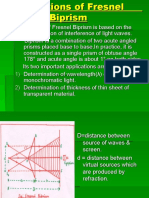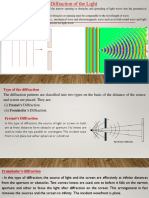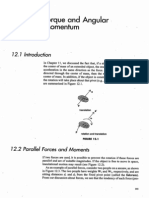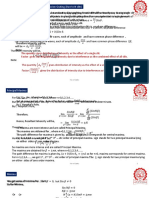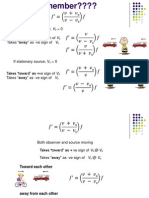Intro Optics - PPT V2part 05
Intro Optics - PPT V2part 05
Uploaded by
buffmomCopyright:
Available Formats
Intro Optics - PPT V2part 05
Intro Optics - PPT V2part 05
Uploaded by
buffmomOriginal Description:
Original Title
Copyright
Available Formats
Share this document
Did you find this document useful?
Is this content inappropriate?
Copyright:
Available Formats
Intro Optics - PPT V2part 05
Intro Optics - PPT V2part 05
Uploaded by
buffmomCopyright:
Available Formats
N Source Interference 0
N Slit I nterference: The Diffraction Grating
N Source Interference 1
N Slit I nterference: The Diffraction Grating
Calculate the irradiance at an observation point P when we have a
superposition field from N sources (slits) an array of slits. We
make the usual assumption that the observation point is far away
from the slits or in the focal plane of a lens. Assume the slits are
equidistantly spaced by distance a.
N Source Interference 2
N Slit I nterference: The Diffraction Grating
The superposition field at P due to the array of N identical,
equidistantly spaced slits S1 SN is:
or
where |
i
is the phase change of the field in propagating from S
i
P.
We can write:
N Source Interference 3
N Slit I nterference: The Diffraction Grating
Calculate the phase differences |
i
- |
1
:
The optical path difference for neighbouring sources is A = nasinu or,
for the usual case in air (n=1), A = asinu . The phase difference
between fields from neighbouring sources is thus o |
I+1
- |
i
= k
0
A.
N Source Interference 4
N Slit I nterference: The Diffraction Grating
So, we have:
The series can be determined in closed form using:
with
This gives:
N Source Interference 5
N Slit I nterference: The Diffraction Grating
This result can be rearranged using:
So:
N Source Interference 6
N Slit I nterference: The Diffraction Grating
Thus, for the superposition field at P, we can write:
Define:
and
Then:
N Source Interference 7
N Slit I nterference: The Diffraction Grating
Note:
o = o /2 where o is the phase difference between field components
at P arriving from any two neighbouring sources.
|
0
is the phase change undergone by a field propagating from the
centre of the array of slits to P.
N Source Interference 8
N Slit I nterference: The Diffraction Grating
Now, given the field at P, the irradiance at P is determined by:
where, I
0
is the irradiance at P due to one slit alone and
for n = 1 (air).
N Source Interference 9
N Slit I nterference: The Diffraction Grating
Behaviour of the function:
Principal Maxima
Minima (Zeroes)
N Source Interference 10
N Slit I nterference: The Diffraction Grating
Principal Maxima (Bright Fringe)
For this value of o , the denominator sino 0. We evaluate the
function with LHopitals Rule:
N Source Interference 11
N Slit I nterference: The Diffraction Grating
Principal Maxima (Bright Fringe)
Thus:
At a principal maximum:
N Source Interference 10
N Slit I nterference: The Diffraction Grating
Principal Maxima (Bright Fringe)
For these values of
o , the irradiance at
P takes on its
maximum value.
N Source Interference 12
N Slit I nterference: The Diffraction Grating
Minima (Zeroes) (Dark Fringe)
For these values of o, the numerator of the function goes to zero as
the denominator remains finite. It can be shown that, for these
values of o , sino = sin(pt /N) = 0.
Looking at the possible values of o that give a zero, we see that
there are N-1 zeroes between adjacent principal maxima.
N Source Interference 13
N Slit I nterference: The Diffraction Grating
Example: N=3
sin(8t /3)
0 8t /3 2 2 Dark
sin(7t /3)
0 7t /3 1 2 Dark
0
0 2t - 2 Bright
sin(5t /3)
0 5t /3 2 1 Dark
sin(4t /3)
0 4t /3 1 1 Dark
0
0 t - 1 Bright
sino sinNo o p m Fringe
N Source Interference 14
N Slit I nterference: The Diffraction Grating
Example: N=3
N Source Interference 15
N Slit I nterference: The Diffraction Grating
Example: N=6
N Source Interference 16
N Slit I nterference: The Diffraction Grating
Note: There are N-2 Minor Maxima (separating the zeroes)
between adjacent principal maxima.
These can be located by the mathematical condition:
A Transcendental Equation very hard to solve!! (must be done
numerically or graphically).
N Source Interference 17
N Slit I nterference: The Diffraction Grating
Example: A graphical
solution for N=7.
The functions Ntano and
tanNo are plotted versus o
on the same graph.
Intersection points indicate
solutions to the equation
Ntano = tanNo and give
the corresponding values
of o .
o (degrees)
N Source Interference 17a
N Slit I nterference: The Diffraction Grating
Check: Youngs Double Slit N=2.
For N=2, make use of the trig identity sin2o = 2sino coso to get
I = 4I
0
cos
2
o .
Another trig identity: 2cos
2
o = 1 + cos2o gives:
I = I
0
(1 + cos2o ) = I
0
(1 + coso ) = I
0
(1 + cos [k
0
asinu] )
(as before) where o = 2o is the phase difference in fields at P
from neighbouring slits.
N Source Interference 17b
N Slit I nterference: The Diffraction Grating
Some irradiance patterns for N slits:
N=2
N=3
N=7
N=15
N Source Interference 18
N Slit I nterference: The Diffraction Grating
Recall:
The optical path
difference for
neighbouring sources is
A = asinu .
The phase difference
between fields from
neighbouring sources is
thus o = k
0
A.
N Slit Interference Pattern: Phasor Picture
N Source Interference 19
N Slit I nterference: The Diffraction Grating
To understand the irradiance pattern in the phasor picture, we can
rewrite the irradiance formula in terms of o :
Principal Maximum:
Zero:
N Slit Interference Pattern: Phasor Picture
N Source Interference 20
N Slit I nterference: The Diffraction Grating
N Slit Interference Pattern: Phasor Picture
Example: N=4
N Source Interference 21
N Slit I nterference: The Diffraction Grating
N Slit Interference Pattern: Phasor Picture
Example: N=4
N Source Interference 22
N Slit I nterference: The Diffraction Grating
N Slit Interference Pattern: Phasor Picture
Example: N=4
N Source Interference 23
N Slit I nterference: The Diffraction Grating
N Slit Interference Pattern: Phasor Picture
Example: N=4
N Source Interference 24
N Slit I nterference: The Diffraction Grating
Important Properties of the Grating
As N :
(1) Irradiance into a minor maximum 0.
(2) Width of a principal maximum 0
(ie bright fringes become narrow)
Principal Max:
Zero:
N Source Interference 25
N Slit I nterference: The Diffraction Grating
Important Properties of the Grating
N Source Interference 26
N Slit I nterference: The Diffraction Grating
Proof of Property (1): Irradiance into a minor maximum 0.
Choose N odd minor max midway between principal maxima.
N Source Interference 27
N Slit I nterference: The Diffraction Grating
Now:
is an odd multiple of t /2
is also an odd multiple of t /2 since N is odd.
Since sin[ odd multiple of t /2 ] = 1:
Thus:
This ratio 0 as N and the minor maximum disappears
(relative to the principal maximum). QED
N Source Interference 28
N Slit I nterference: The Diffraction Grating
Proof of Property (2): Width of a principal maximum 0
Take a measure of the width of the principal maximum to be the
separation (in o) between zeroes on either side of the peak:
QED
N Source Interference 29
N Slit I nterference: The Diffraction Grating
The Grating as a Spectroscopic Device.
Consider the case of large N when the grating is illuminated by
light consisting of two wavelength components:
01
and
02
Principal Max:
A grating (large N) illuminated by red and green lasers.
N Source Interference 29a
N Slit I nterference: The Diffraction Grating
The Grating as a Spectroscopic Device.
Consider the case of large N when the grating is illuminated by
light consisting of two wavelength components:
01
and
02
Principal Max:
N Source Interference 30
N Slit I nterference: The Diffraction Grating
The grating can disperse constituent colours in a light beam:
a Grating Spectrometer.
2
02
/ a
2
01
/ a
02
/ a
01
/ a
2
nd
order
spectrum
1
st
order
spectrum
0
th
order spectrum
(non-dispersive)
1
st
order
spectrum
(again!)
G
r
a
t
i
n
g
L
e
n
s
Lens focal
plane
sinu
N Source Interference 30a
N Slit I nterference: The Diffraction Grating
Grating illuminated by a white light source:
The two 1
st
order white light spectra are visible
and the central, non-dispersive , 0
th
order .
N Source Interference 30b1
N Slit I nterference: The Diffraction Grating
Grating (600lines/mm) illuminated by a helium gas discharge
source:
The two 1
st
order spectra are visible and the
central, non-dispersive , 0
th
order .
N Source Interference 30b2
N Slit I nterference: The Diffraction Grating
Grating (600lines/mm) illuminated by a hydrogen gas discharge
source:
The two 1
st
order spectra are visible and the
central, non-dispersive , 0
th
order .
N Source Interference 30b3
N Slit I nterference: The Diffraction Grating
Grating (600lines/mm) illuminated by a neon gas discharge
source:
The two 1
st
order spectra are visible and the
central, non-dispersive , 0
th
order .
N Source Interference 30c
N Slit I nterference: The Diffraction Grating
Some irradiance patterns for N slits illuminated by white light:
N=2
N=3
N=7
N=15
N Source Interference 31
N Slit I nterference: The Diffraction Grating
Reflection Grating Spectrometer.
Reflection Grating: strips etched out of a reflective surface.
2
nd
order
spectrum
1
st
order
spectrum
0
th
order
(specular
reflection)
N Source Interference 32
N Slit I nterference: The Diffraction Grating
The resolution (ie ability to separate constituent wavelengths)
improves with increasing N.
Small N blended
(unresolved) spectral
lines.
Large N distinct
(resolved) spectral
lines.
N Source Interference 33
N Slit I nterference: The Diffraction Grating
Grating Spectrometer with N=2 !
Irradiance patterns for
the two component
wavelengths.
Irradiance measured
by a wavelength
insensitive detector.
N Source Interference 34
N Slit I nterference: The Diffraction Grating
Grating Spectrometer with N=20 .
Irradiance patterns for
the two component
wavelengths.
Irradiance measured
by a wavelength
insensitive detector.
N Source Interference 35
N Slit I nterference: The Diffraction Grating
Grating Spectrometer.
You might also like
- C. C + v. C - v. V - C.: Ib Physics HL Multiple Choice Review Waves & Vibrations 1Document20 pagesC. C + v. C - v. V - C.: Ib Physics HL Multiple Choice Review Waves & Vibrations 1shammi nathanNo ratings yet
- Ilovepdf MergedDocument16 pagesIlovepdf MergedAayush KumarNo ratings yet
- InterferenceDocument44 pagesInterferencePrincess HibaNo ratings yet
- Tan Kok Chooi: ZCT 215 Optics Diffraction Grating No.1Document33 pagesTan Kok Chooi: ZCT 215 Optics Diffraction Grating No.1shafinaNo ratings yet
- (Feng K., Li L., Jiao W.) 632.8-Nm Visible RegionDocument6 pages(Feng K., Li L., Jiao W.) 632.8-Nm Visible RegionsinnochiNo ratings yet
- Lab O3: Snell's Law and The Index of Refraction: Fall 2004Document8 pagesLab O3: Snell's Law and The Index of Refraction: Fall 2004mayank98108No ratings yet
- To Determine The Wavelength of Laser Light Using Single Slit Diffrac-Tion PatternDocument8 pagesTo Determine The Wavelength of Laser Light Using Single Slit Diffrac-Tion PatternNiteshNo ratings yet
- Lab 4: Diffraction of LightDocument7 pagesLab 4: Diffraction of LightShouryaNo ratings yet
- Spectral Techniques: SpectraDocument22 pagesSpectral Techniques: SpectrabbteenagerNo ratings yet
- Introduction To Interferometry - Lee - UnknownDocument21 pagesIntroduction To Interferometry - Lee - UnknownBrady WenNo ratings yet
- Wave OpticsDocument14 pagesWave Opticsadars251No ratings yet
- Lab O3: Snell's Law and The Index of Refraction: Fall 2004Document8 pagesLab O3: Snell's Law and The Index of Refraction: Fall 2004Abcxyz XyzabcNo ratings yet
- DiffractionDocument13 pagesDiffractiondipendra dhunganaNo ratings yet
- Laser Amplifier: Spontaneous Emission AbsorptionDocument11 pagesLaser Amplifier: Spontaneous Emission AbsorptionLucky WibisonoNo ratings yet
- 01 Optics Part III Diffraction DHK Se AjwjejjsehDocument18 pages01 Optics Part III Diffraction DHK Se AjwjejjsehNareshNo ratings yet
- Fresnel BiprismDocument18 pagesFresnel BiprismRohan RajagopalNo ratings yet
- Newton Rings AssignmentDocument29 pagesNewton Rings AssignmentSahil MundelNo ratings yet
- UNIT2 Interference DiffractionDocument57 pagesUNIT2 Interference Diffractionfunkpatel123No ratings yet
- Week8 InterferometersDocument84 pagesWeek8 InterferometersArijit PanigrahyNo ratings yet
- Diffraction: Figure 1 - Diffraction Through An ApertureDocument4 pagesDiffraction: Figure 1 - Diffraction Through An ApertureloulepetitloupNo ratings yet
- 4 Wave Optics 2Document18 pages4 Wave Optics 2sudha24_7100% (1)
- Interference of LightDocument23 pagesInterference of LightShafin AnowarNo ratings yet
- Polarization of Light: Malus' LawDocument9 pagesPolarization of Light: Malus' LawCyrene MBolañosNo ratings yet
- Engineering Physics Lab: List of ExperimentsDocument24 pagesEngineering Physics Lab: List of ExperimentsSandeep BuntyNo ratings yet
- I CycleDocument10 pagesI Cyclelaughingbuddha619No ratings yet
- InterferenceDocument49 pagesInterferenceHariom RavatNo ratings yet
- MODERN PHYSICS: Unit 2Document11 pagesMODERN PHYSICS: Unit 2Self Study Zone IndiaNo ratings yet
- E3877 Optics FormulasDocument6 pagesE3877 Optics FormulasKaran DoshiNo ratings yet
- Reflection, Refraction and The Prism: (Material Taken From: Optics, by E. Hecht, 4th Ed., CH: 4, 5)Document5 pagesReflection, Refraction and The Prism: (Material Taken From: Optics, by E. Hecht, 4th Ed., CH: 4, 5)Karen GinaNo ratings yet
- 2 DiffractdionDocument124 pages2 DiffractdionShrinivas PrabhuNo ratings yet
- Determination of Wavelength of Light by Newton's Rings MethodDocument2 pagesDetermination of Wavelength of Light by Newton's Rings MethodDipankar Mishra100% (2)
- A Project Report On Wavelength of Sodium Light Using Newton's RingsDocument27 pagesA Project Report On Wavelength of Sodium Light Using Newton's RingsAnirudh Mittal100% (1)
- Newton'S Ring ExperimentDocument5 pagesNewton'S Ring ExperimentParth NanuNo ratings yet
- BiprismDocument35 pagesBiprismAviral99No ratings yet
- Diffraction Grating Inci&Mini Devation1Document4 pagesDiffraction Grating Inci&Mini Devation1Rangothri Sreenivasa SubramanyamNo ratings yet
- Diffraction Modified Aug2011Document93 pagesDiffraction Modified Aug2011Shrinivas PrabhuNo ratings yet
- He-Ne LaserDocument4 pagesHe-Ne LaserSanchit MishraNo ratings yet
- Part III Basic DevicesDocument105 pagesPart III Basic DeviceshstrybestNo ratings yet
- Fraunhofer DiffractionDocument4 pagesFraunhofer DiffractionKshitij GulatiNo ratings yet
- Review Wave OpticsDocument46 pagesReview Wave OpticsSilicone GlossNo ratings yet
- CH - 20 Interference of Light - CompressedDocument12 pagesCH - 20 Interference of Light - Compresseddipanshukanhaiyapandey2006No ratings yet
- 6 2 Formulae Wave OpticsDocument12 pages6 2 Formulae Wave OpticsNathanian50% (2)
- Observation Table - Diffraction GratingDocument5 pagesObservation Table - Diffraction GratingVivek SinghNo ratings yet
- Atomic Line Spectra of Noble Gases and Metallic Vapors: Experiment No. 1Document6 pagesAtomic Line Spectra of Noble Gases and Metallic Vapors: Experiment No. 1ayushNo ratings yet
- WRN3 K 2 Ur Rhs 654 ZF Eoe NDocument86 pagesWRN3 K 2 Ur Rhs 654 ZF Eoe NMayank BaghelNo ratings yet
- Tut6 SolDocument11 pagesTut6 Solanon_965498458No ratings yet
- Fresnel Biprism ExperimentDocument11 pagesFresnel Biprism ExperimentanuragNo ratings yet
- Youngs Double Slit ExperimentDocument8 pagesYoungs Double Slit ExperimentselesmabNo ratings yet
- Diffraction SlideDocument21 pagesDiffraction SlideAAKASH ChopraNo ratings yet
- 37 Interference in LightDocument51 pages37 Interference in Lightmohammad faiyazuddinNo ratings yet
- Lab2 DispersionDocument7 pagesLab2 DispersionvizayharmaNo ratings yet
- Unit-3-Sure Success-DiffractionDocument11 pagesUnit-3-Sure Success-DiffractionARPITNo ratings yet
- Fraunhoffer Diffraction at Single SlitDocument11 pagesFraunhoffer Diffraction at Single SlitReddyvari VenugopalNo ratings yet
- Experiment 8 Diffraction Grating: ApparatusDocument7 pagesExperiment 8 Diffraction Grating: ApparatusAARYA ATTREYNo ratings yet
- DiffractionDocument8 pagesDiffractionavi taylorNo ratings yet
- DiffractionDocument32 pagesDiffractionHajra MazharNo ratings yet
- Group 2 Newton's Ring ExperimentDocument26 pagesGroup 2 Newton's Ring ExperimentShawn HunterNo ratings yet
- InterferenceDocument49 pagesInterferenceKNo ratings yet
- Feynman Lectures Simplified 2C: Electromagnetism: in Relativity & in Dense MatterFrom EverandFeynman Lectures Simplified 2C: Electromagnetism: in Relativity & in Dense MatterNo ratings yet
- Electron Beam-Specimen Interactions and Simulation Methods in MicroscopyFrom EverandElectron Beam-Specimen Interactions and Simulation Methods in MicroscopyNo ratings yet
- Advanced Exercise PlanDocument66 pagesAdvanced Exercise PlanbuffmomNo ratings yet
- Jump Master JMPIDocument6 pagesJump Master JMPIbuffmomNo ratings yet
- Balance Chemical EquationsDocument17 pagesBalance Chemical EquationsbuffmomNo ratings yet
- Barrons Torque and Angular MomentumDocument16 pagesBarrons Torque and Angular MomentumbuffmomNo ratings yet
- Physics Help Problems W SolutionsDocument11 pagesPhysics Help Problems W SolutionsbuffmomNo ratings yet
- Measurement of UncertaintyDocument15 pagesMeasurement of UncertaintybuffmomNo ratings yet
- Curva AsfalticaDocument55 pagesCurva AsfalticaWilliam Francisco NIETO CONTRERASNo ratings yet
- Interference & DiffractionDocument36 pagesInterference & DiffractionsalafismeNo ratings yet
- DPP 3 Waves On StringDocument3 pagesDPP 3 Waves On Stringupanshupandit3No ratings yet
- 10.WAVE OPTICS (Problem for practice)Document4 pages10.WAVE OPTICS (Problem for practice)bhavishypourushNo ratings yet
- Leok 9Document2 pagesLeok 9Ali RumyNo ratings yet
- Kelvin WedgeDocument28 pagesKelvin WedgeHua Hidari YangNo ratings yet
- Wave Optics AssignmentDocument2 pagesWave Optics AssignmentSugam KapoorNo ratings yet
- CoherenceDocument20 pagesCoherenceRajni Aggarwal0% (1)
- Intensity Distribution in Plane Transmission Grating (Due To N Slits)Document5 pagesIntensity Distribution in Plane Transmission Grating (Due To N Slits)Aakash YadavNo ratings yet
- Ap Unit-1 Notes 2022-23Document15 pagesAp Unit-1 Notes 2022-23Smd nazeebNo ratings yet
- 3.2. Refraction, Diffraction and Interference MCQ MADocument10 pages3.2. Refraction, Diffraction and Interference MCQ MAsanjana shettyNo ratings yet
- On Single-Slit DiffractionDocument9 pagesOn Single-Slit DiffractionInformation LearnerNo ratings yet
- Wave Optics 1 Page NotesDocument2 pagesWave Optics 1 Page NoteswytaziNo ratings yet
- SuperpositionDocument42 pagesSuperpositionshazadrahmanchyNo ratings yet
- How To Remember (Doppler Effect)Document3 pagesHow To Remember (Doppler Effect)fuzing_2012No ratings yet
- Wave Worksheet: InstructionsDocument1 pageWave Worksheet: Instructionsafaflotfi_155696459No ratings yet
- Superposition and Standing Waves: PHYS220, Spring 2019-2020, by Dr. Salam SakrDocument8 pagesSuperposition and Standing Waves: PHYS220, Spring 2019-2020, by Dr. Salam SakrSavio KhouryNo ratings yet
- Physics XII CH 10 Physics Assertion Reasoning Wave OpticsDocument8 pagesPhysics XII CH 10 Physics Assertion Reasoning Wave OpticsNjan KL16么Porotta100% (1)
- Wave Optics - I: Created by C. Mani, Principal, K V No.1, AFS, Jalahalli West, BangaloreDocument16 pagesWave Optics - I: Created by C. Mani, Principal, K V No.1, AFS, Jalahalli West, BangaloreJinshy VinodNo ratings yet
- 4.4 Waves - Superposition MSDocument20 pages4.4 Waves - Superposition MSwillowchenchenNo ratings yet
- Structured Questions-Wave: 1. This Question Is About The Superposition of WavesDocument6 pagesStructured Questions-Wave: 1. This Question Is About The Superposition of WavesZero TwoNo ratings yet
- BEATSDocument9 pagesBEATSrizwansiddiqui1970No ratings yet
- F5C1 (Tutorial1 7)Document3 pagesF5C1 (Tutorial1 7)ChewLee TanNo ratings yet
- Physics Interference Class 12Document13 pagesPhysics Interference Class 12jatinarora5568No ratings yet
- Experiment 07Document13 pagesExperiment 07Nisa Abdullah0% (2)
- Diffraction - A4 PDFDocument51 pagesDiffraction - A4 PDFAntoniaMariaNo ratings yet
- YDSE and Wave OpticsDocument2 pagesYDSE and Wave OpticskritikaNo ratings yet
- Chapter 23Document33 pagesChapter 23hafizszul AmirushamNo ratings yet
- EHB465E Lecture 2 - Wave OpticsDocument28 pagesEHB465E Lecture 2 - Wave OpticsfrknNo ratings yet

